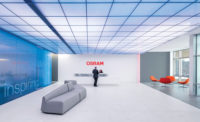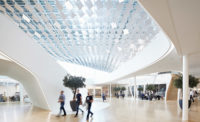Reiss Headquarters
Squire & Partners outfits a clothing retailer's headquarters in a luminous acrylic cloak.
Architects & Firms
London, England
For a moment, the trendy shoppers of London’s Oxford Street may think they’ve landed in Omotesando or Roppongi Hills. A new five-story building for the upscale fashion chain Reiss stands at the terminus of a branch of this high street, and its design, by Squire & Partners, evokes the elegant yet jaw-dropping architecture that has transformed far-away neighborhoods into destinations of commerce and culture.
Not surprisingly, the clothing chain’s namesake, David Reiss, travels extensively. In 2005, fresh from another transcontinental trip, Reiss asked four British firms to propose designs for a new global headquarters and flagship store, which would replace a small complex that had once housed the London School of Fashion. “He liked the idea of having his own building that reflected his brand, as in Hong Kong or Japan, but he didn’t want it to be too shouty,” says Alessandro Mangiavacchi, the Reiss project architect for Squire & Partners. “It was a very open brief—just a delicate, elegant building to reflect the Reiss brand.”
The Squire team won the job handily. Reiss had wanted to consolidate several locations into the facility, and accordingly invited contestants to accommodate a three-story retail space, third- and fourth-floor offices and workshops, and a founder’s penthouse in their submissions. The vertical integration of functions reminded Mangiavacchi and his teammates of the historic paradigm of the tailor’s shop, and they originally imagined expressing the traditional rag trade by dressing the building in fabric—either by sandwiching it between layers of glass or draping it delicately behind the transparent material and changing it with the seasons.
Even the most haute engineering couldn’t justify the use of glass, however. “We spent a considerable number of months [contemplating] how we can use cast or cold-formed glass, and the more we looked the more we realized that it was quite difficult to actually produce what we wanted,” Mangiavacchi says. Cast glass, for example, offered an organic look, “but we weren’t quite sure how the slumps would end up. So we started looking for a material that was crisper, and that we could control to our requirements.”
Despite its high cost, and questionable material properties like UV resistance, Squire and Reiss ultimately settled on applying a milled acrylic screen to a double-glazed curtain wall. The move yielded multiple benefits. The veil acts as a rain screen while also creating an energy-saving stacking effect in the airspace between itself and the curtain wall. In addition, acrylic conducts light more dramatically than glass.
Indeed, at night, LEDs integrated with the bottom of each of the screen’s 4.9-foot-wide acrylic panels cast bright, evenly distributed white light across the public face of the new Reiss headquarters. Squire’s architects amplified the luminosity by chamfering the top of each panel to 86 degrees, an angle that reflects the LEDs’ upward-pointing beams back onto the panel. “It looks straightforward and simple, but there’s a lot of engineering that you don’t necessarily perceive,” Mangiavacchi says.
The statement sums up the entire facade system. Ranging in height from 11.8 feet to 13.8 feet, the acrylic panels are milled to a frosted or clear finish and seemingly randomly routed to a depth of 0.12 inches in a dogtooth or equilateral-triangle profile. To put the screen in place, the design team fashioned a series of steel mullions that suspend from the roof; a 2-inch vertical gap between one mullion and the next eases lateral wind loading. The panels are then placed into each compartment; for reinforcement, two loading blocks on each bottom corner weigh down the panels, and a teardrop-shaped stainless-steel rod is inserted into vertical channels “[to] prevent the panels from falling off the building,” Mangiavacchi explains. The LEDs are hidden within a brushed-aluminum cap that runs between the loading blocks, and although each of these strips can be programmed to fade in and out or change color temperature, currently Reiss has decided to keep the lights at the same levels as they were originally installed.
Thanks to its intricate engineering and detailing, Reiss’ acrylic screen produces multiple visual effects even before the sun goes down. In morning, sunlight hits the building at a low angle, bouncing off the milled acrylic to create a milky white haze that obscures the view of passersby. Toward noon, the building is lit from within and appears more transparent, revealing clothing’s path from seamstress to consumer. And at dusk, the headquarters wears the architectural version of a silk slip, its gauze-like acrylic surface shimmering in LEDs’ glow, occasionally allowing an inside glimpse of loyal fashionistas in their element.


